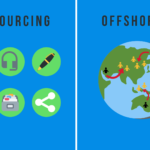Ecommerce Strategies: Starting 2019 on the Right Foot
Ecommerce business has been booming of late; some might even say the growth is out of this world. As more of the population, when looking to go shopping, turn to their keyboards rather than their car, online retailers have seen a major uptick in business. According to Statista, as of 2017, Ecommerce retail trade sales in Canada amounted to over 1.8 Billion Canadian dollars, and revenues are expected to reach almost 29 Billion Canadian dollars by 2021.
If you are an Ecommerce retailer, you are no doubt looking forward to an even more profitable 2019. But you might be left wondering: what else can you do to capitalize on the favourable current climate? How can you offer an attractive experience while cutting overhead, maximizing conversion rates and growing profits? With those questions in mind, this article will look at three major Ecommerce strategies you can implement for the year ahead: courier brokerage, social engagement and abandoned cart retargeting. Let’s take a look.

Courier Brokerage – Why Online Retailers/Stores/Websites Use Them?
Because of the very fierce competition among online sellers, some websites offer free shipping to customers just to snag a sale. Amazon and the other big time online retailers like Walmart, QVC, Ebay and others use UPS, FedEx and US Postal for shipping services, but they can afford to do this since the volume of their sales is so huge that shipping expenses are absorbed. It is an unfair advantage that the megastores have over the little guys, but a courier broker can help even the playing field a bit.
For all you smaller businesses, in order to lower your operating costs you must find ways to save money when shipping your packages both near and far. This is where using a third party courier broker can help you save money on shipping expenses, thus making the final cost of your products less expensive for your customers. By using discounted courier services, smaller companies can save money, which they can pass on to their customers.
There are differences in using standard postage versus courier services. Standard postage is sent through the public postal service like Canada Post, or the USPS, whereas courier mail services are managed by private businesses. A courier, just like the postal service, can transport any manner of letters and packages, but they can also handle bulky items such as furniture, appliances and oddly shaped packages. Since couriers are private and specialized, they also offer more sophisticated package tracking technology, and quicker transport times.
What a Courier Broker Can Do?
Courier brokers save companies money on shipping by giving them discounted rates for volume shipping. By negotiating bulk deals with these courier companies, they are then able to pass the savings along to Ecommerce retailers. To attract businesses, courier brokers offer a lot of shipping choices including but not limited to reliable services like UPS, FedEx or USPS. etc.
This means, just like ordinary buying or purchasing, a business can maximize saving their money on shipping costs by shopping around for the best and cheapest courier service. This doesn’t only save money but it also saves retailers’ time, and will give them the best deals possible on international and local shipping.
In this competitive world, days are gone when businesses can just rely on Canada Post or USPS. The future of shipping now includes courier brokerage. With a courier broker, enterprises have the choice of dozens of couriers in Canada and the US, like Purolator, DHL, UPS, FedEx, Aramex, etc.
Social Engagement – Why Its Important for Retailers?
According to Pew Research Center, 84% of online buyers consult at least one social media site before making a purchase, and according to research done by BigCommerce, nearly a quarter of E-shoppers are influenced by recommendations they see on social media. The picture that paints is pretty clear: a lot of shoppers rely on social media, if not for influence than at least for a review of their options. Social media engagement, therefore, is of paramount importance.
The term “omnichannel” was tossed around often in 2018, and for good reason; looking forward to the year ahead, you can expect more and more shoppers to rely on various platforms and channels to do their shopping. As consumers become ever more reliant on their phones, expect social to represent a huge chunk of those channels.
How to Create & Measure Effective Engagement?
When discussing effective engagement, you’re really talking about two key metrics: the amplification of mentions and the quality of the dialogue surrounding those mentions. In essence, you are looking at quantity and quality.
Creating effective engagement over social media therefore requires a twofold approach. You want to be visible across platforms, but you want to be directed and on-brand enough that you can build clout on the platform where your business makes sense. For instance, if you own a jewellery store, by all means advertise on Facebook, Twitter, etc., but you should probably place more of your efforts toward visual-based platforms like Pinterest or Instagram.
Once you are confident in your social media strategy, you need to track engagement by creating KPIs (Key Performance Indicators) unique to your business. Whether those are click-throughs, likes, shares, sales – whatever you have deemed important to the overall success of your business – track them, then tweak your strategy to meet your KPI goals.
There are plenty of in-platform analytics software that can help you through the process, as well as the always reliable Google Analytics and scores of third party tools. Where a courier broker helps you increase profit once a sale is made, social engagement helps you get that sale in the first place. But what happens if you are successful in your engagement, yet fail to make the sale when the customer is at checkout? To round out your effective Ecommerce strategies, you need to implement the following…

Abandoned Cart Retargeting – Why Retailers Should Focus on Retargeting Abandoned Carts?
Shopping cart abandonment, for those who might not know, is when a customer adds items to their shopping cart (assumedly with the intent of buying), but backs out before actually purchasing anything. It is frustrating for Ecommerce retailers, and is often symptomatic of a problem in the checkout process.
Courier brokerage is an effective hedge against shopping cart abandonment, because it lowers the price of shipping, which for some shoppers can be a strong deterrent. If your shopping cart abandonment rate is still high after going with a courier broker, the issue might also be because of either a complex checkout process, or a checkout process that requires shoppers to sign up. Essentially, you want to eliminate any and all barriers to entry. Whatever gains you might make by having customers sign up could easily be erased by shopping cart abandonment.
The ease and convenience of Ecommerce can be a double-edged sword. It is great for getting people in the door, but as easy as it is to shop online, it is just as easy to walk away. This is one advantage brick and mortar stores have over Ecommerce – once items are in a physical shopping cart, they tend to make their way through checkout!
How Marketing Automation Can Help You Retarget A Lost Shopping Cart
All is not lost, though. There are certain steps you can take in order to attract that customer back, the best of which is to use a marketing automation tool. With a marketing automation tool, you can create a custom workflow that recognizes when items are added to a shopping cart and then never checked out.
Simply program the amount of time you want elapsed between adding items and not checking out (let’s say 12 hours), and create a helpful follow up email for the automation tool to send to the customer after that period has elapsed. This reminds the customer of the product they were shopping for, and can be very successful in turning abandoned carts into sales.
Other plugins allow you to forego the email process entirely, instead making use of push notifications. Your site can ask you users for their permission to send push notifications; if they accept, you can send notifications directly to their desktop in the event of a failed conversion. Some shoppers see push notifications as being a little too… well, pushy. But they can nevertheless be effective converters.
You can also retarget with display ads, as per this helpful article from EZ. You can do this, they suggest, by putting a Javascript sequence on each page of your website that creates a cookie to follow visitors. This way, you can retarget shoppers after they leave, over Facebook, Twitter and other social media platforms.
Starting 2019 Ecommerce on the Right Foot
To recap, courier brokers improve your ecommerce website by making it easier to use for customers, and ensure that you don’t suffer shopping cart abandonment when patrons see the shipping price. They negotiate discounted prices, especially on volume shipments, and demonstrate money savings via comparison-shopping on multiple carriers and delivery options.
Social media engagement allows you to effectively target consumers on the platforms they are most influenced by. Creating a twofold strategy that combines cross-platform visibility with direct and dedicated branding over one or two appropriate platforms, you can amplify your mentions and control the quality of those mentions.
Finally, retargeting your abandoned shopping carts allows you to convert more of those engagements you’ve worked so hard for. Either by email, push notifications or display ads, you can gently remind shoppers of the great products or services your Ecommerce store has to offer.
Kick 2019 off on the right foot, using these savvy strategies for your ecommerce business!
















